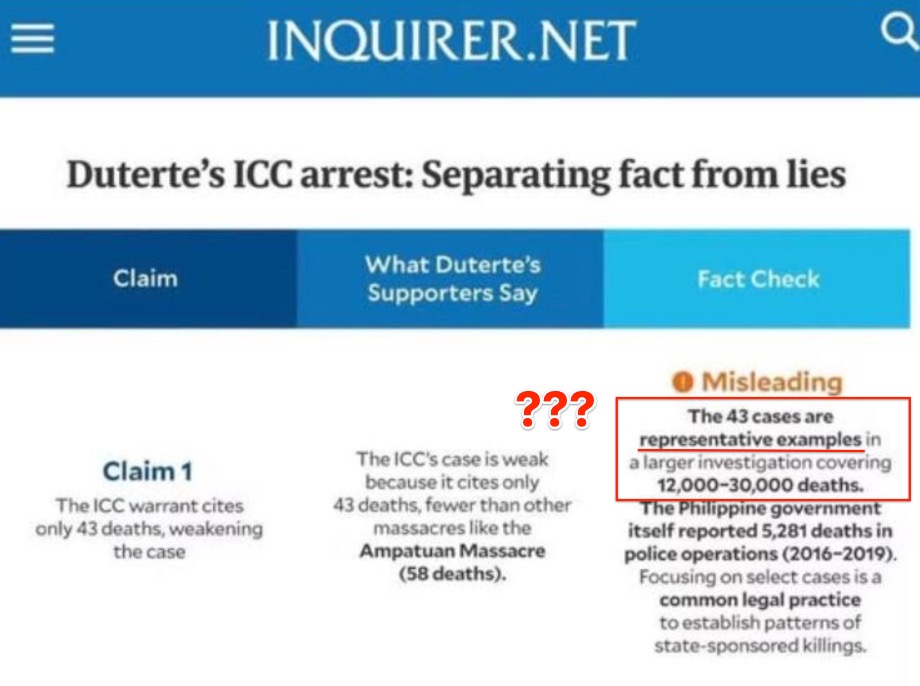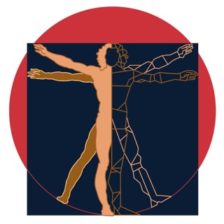Has the International Criminal Court (ICC) appropriately applied statistical methodology in its legal processes regarding the crimes against humanity charges against Duterte?This question arises from a recent Philippine Daily Inquirer (PDI) post, which discusses the ICC’s categorization of 43 cases as “representative examples” amidst a broader investigation into 12,000 to 30,000 deaths (Baclig, 2025). This terminology has sparked significant debate. Critics, including Sass Rogando Sasot, a noted Duterte supporter and scholar with graduate studies from abroad, argue that “representative sample” suggests a statistical method and contend that its use by the ICC raises questions about the credibility of their conclusions, criticizing the PDI for statistical inaccuracies and asserting that the PDI is “bad in math.” (Sasot, 2025)

What does “representative Sample” mean? In statistics, a representative sample accurately mirrors the characteristics of the entire population, allowing researchers to make generalized conclusions about the population from this subset. To borrow Sasot’s example, this concept is akin to tasting a spoonful of soup to gauge the entire pot’s seasoning, if the spoonful is representative, one can reasonably infer the overall flavor. However, this requires careful selection to ensure the sample embodies the diverse characteristics of the whole population. Sasot points out that statistical principles of representative sampling involve calculating sample sizes to allow for meaningful and accurate extrapolations. According to Sasot, for instance for populations of 30,000 and 6,000, typical representative samples would be around 379 and 361 individuals, respectively, to achieve a 95% confidence level with a ±5% margin of error. Sasot argues that the ICC’s selection of just 43 cases to represent thousands inherently carries a high margin of error, severely undermining the reliability of any extrapolations made (Sasot, 2025). This small sample size can hardly capture the complex dynamics and variability of large-scale international crimes, potentially leading to skewed or incomplete findings. From a statistical analysis perspective, Sasot is correct. Additionally, considering this low number of cases, which cannot be statistically justified, the charge of “crimes against humanity” becomes difficult to substantiate, as such charges require a comprehensive understanding of widespread or systematic actions, which this sample fails to adequately represent.
“REPRESENTATIVE EXAMPLE” VS. “REPRESENTATIVE SAMPLE” VS. “SAMPLE” VS. “REPRESENTATIONS”
I could be mistaken, but browsing through the ICC website and the available documents I have read related to Duterte’s case, the ICC seems to have never used the term “representative example.” This term seems to be used only by the PDI as far as I know. The ICC, however, uses terms like “representations,” “a sample of alleged incidents,” and others to conclude that there is “a widespread and systematic attack directed against the civilian population.” (International Criminal Court, 2025) For building a case of crimes against humanity filed against Duterte, such terms, although immediately associated with statistical analysis, should not be confused with the statistical concept of a representative sample. In legal contexts, particularly in international law, demonstrating a pattern of crimes does not typically involve statistical analysis but focuses on constructing a legal narrative through meticulously selected cases. These cases are chosen based on the strength of evidence, legal relevance, and their capacity to demonstrate systematic or widespread criminal conduct.
The ICC prosecutes the most severe international crimes, including genocide, war crimes, crimes against humanity, and aggression. When multiple instances of such crimes occur, the Office of the Prosecutor selects specific charges that exemplify broader illegal conduct. This selection focuses on incidents or behaviors that represent the larger scale of the crimes. By choosing a “sample of alleged incidents,” the ICC aims to create a cohesive and clear narrative that illustrates the perpetrator’s role and the systematic nature of the crimes, thereby providing a thorough legal examination of the key aspects of the criminal behavior. This method also serves judicial efficiency, allowing the Court to manage cases more effectively by reducing the complexity and duration of proceedings. It ensures that the trials remain focused and manageable while still capturing the gravity of the crimes and the impact on victims. Moreover, even though only representative examples are prosecuted, the broader context and the full impact of the accused’s conduct are considered during sentencing and reparations, ensuring that legal outcomes reflect the extensive nature of the criminal activities, even if not all incidents are brought to trial.
In short, the ICC’s approach of using representative examples is a strategic legal practice designed to manage large-scale international prosecutions efficiently, ensuring that justice is both practical and reflective of the crimes’ serious nature. In fairness, the ICC has never claimed that the terms they use are akin to “representative sampling” in statistical analysis. For them to demonstrate a pattern of crimes, there need not be a need for statistical analysis, but rather the focus is on the legal narrative constructed through meticulously selected cases. These cases are chosen based on the strength of evidence, legal relevance, and their ability to demonstrate systematic or widespread criminal conduct.
SO, WHO IS CORRECT?
While both Sass Rogando Sasot and the ICC present valid viewpoints, with Sasot emphasizing a statistical approach and the ICC a legal perspective, I argue that there is considerable room for improvement in the ICC’s methodology and the terminology it uses. Their current approach risks being perceived as intellectually dishonest if not adequately addressed. The method the ICC employs to select cases may appear arbitrary or influenced by factors such as political pressure or media attention, raising significant concerns about the accuracy and fairness of international criminal justice. If the objective is truly to illustrate patterns of atrocities, integrating robust statistical methodologies could significantly enhance the accuracy and comprehensiveness of these patterns, lending more credibility to the ICC’s assertions and ensuring that justice is served comprehensively and fairly. Moreover, the ICC’s practice of selecting a limited number of cases to represent broader crimes might not capture the full scope and diversity of the crimes committed. This could potentially lead to a skewed legal narrative that does not fully address the experiences of all victims or the variety of crimes committed. Such a method could also compromise the thoroughness of justice, as many incidents and therefore, many victims might not see justice served, undermining the ICC’s mission to promote international justice and accountability.
MY RECOMMENDATIONS
Given these challenges, it is crucial for the ICC to revise their methodology or, at the very least, the terminology used to build their case. To this end, I recommend the ICC consider the following actions:
1. Integrate Statistical Analysis
I highly recommend that the ICC incorporate statistical analysis. This integration would provide a quantitative foundation enhancing the credibility and objectivity of the case build-up process. A rigorous statistical approach would allow for a more systematic examination of patterns in the data, ensuring that case selection is not arbitrary but based on measurable trends and representative distributions. By applying statistical methods to assess the prevalence, distribution, and characteristics of alleged crimes, the ICC can better substantiate claims of a widespread and systematic attack directed against the civilian population, a crucial element in legally justifying the alleged charges of crimes against humanity.
At present, it seems that the ICC’s approach appears to lack clear, objective criteria for determining what truly constitutes a crime against humanity. The absence of a quantifiable threshold raises concerns about the logical foundation of its claims and the fairness of its prosecutorial discretion. Without a statistical basis to justify the claim of widespread and systematic violence, the current methodology risks being perceived as arbitrary, politically motivated, and logically and legally inconsistent. Statistical analysis would bridge this gap by providing empirical evidence that validates whether the alleged crimes meet the necessary threshold for a charge of crimes against humanity.
Furthermore, the ICC’s failure to apply statistical rigor undermines its credibility, as it leaves critical questions unanswered: What proportion of the total alleged incidents were systematically directed at a civilian population? How do these figures compare to past cases where crimes against humanity have been successfully prosecuted? A data-driven approach would eliminate such ambiguities, ensuring that charges are based on solid, quantifiable evidence rather than assumptions. This would not only strengthen the ICC’s case but also reinforce public trust in its role as an impartial judicial body, committed to upholding justice with fairness, accuracy, and transparency.
2. Adopt Qualitative Analysis
If statistical analysis confirms a widespread and systematic attack against the civilian population but yields a number of cases too impractical for the court to hear and consider in full, the next step is to refine case selection through qualitative analysis. While quantitative methods provide the necessary statistical foundation to justify claims of crimes against humanity, they do not determine which specific cases should be highlighted in legal proceedings. For this, qualitative analysis plays a crucial role in identifying the most representative and legally significant cases that effectively illustrate the broader pattern of crimes.
Qualitative analysis is widely used across the social sciences to derive deeper insights from complex phenomena. Specifically, the ICC could employ key informant interviews, a method originating in anthropology but now widely adopted in sociology, psychology, and public health (Kibuacha, 2024). This approach involves in-depth conversations with individuals chosen through purposive sampling due to their direct knowledge and experience related to the events under investigation. The selection process continues until saturation is reached, meaning that additional interviews no longer provide new insights (Guest, Bunce, & Johnson, 2006).
At present, it appears that the ICC has not explicitly detailed the use of this methodology, as I do not see it being mentioned in detail in their press releases or publicly available documents. If they do have a methodology, it is obvious that they have not communicated it well; otherwise, they would not face so much criticism. While they might already be employing a similar approach behind the scenes, the absence of a clear and well-communicated methodology leaves their case-building process open to criticism. Without such transparency, the ICC risks being perceived as arbitrary or politically motivated, rather than as an institution that rigorously substantiates its claims through verifiable methods.
Highlighting the qualitative methodology alongside statistical analysis is essential to justify case selection, particularly to the educated public who is sure to demand a higher standard of evidence. Without clearly outlining how specific cases are chosen, the ICC could face accusations of lacking a solid basis for its case buildup thereby undermining the justification for the alleged crime charged.
3. Adopt Clearer Terminology and enhance transparency
When the ICC issues press releases, which are later picked up by mainstream media, it is crucial that they use terms that accurately reflect the methodology of their case selection process. The current ambiguity in terminology has led to widespread misunderstanding, particularly when terms associated with statistical analysis are used incorrectly or imprecisely. This has opened the ICC to criticism and accusations of intellectual dishonesty, as it gives the impression that case selection is arbitrary or lacks a solid methodological foundation.
To prevent such misunderstandings, the ICC should adopt clear, well-defined terminology that properly conveys the rationale behind their case selection. If necessary, they should introduce new terms that are precise and not prone to misinterpretation. For example, instead of using terms that might mistakenly imply statistical representativeness, the ICC could refer to cases as “illustrative cases”, explicitly indicating that these cases are chosen for their ability to demonstrate legal and factual patterns rather than statistical proportionality. Additionally, they could define case selection using a concept like “Informant Consensus Threshold”, a term I propose to highlight the point at which qualitative methodologies such as key informant interviews reach saturation, ensuring that the cases selected reflect recurring themes and key elements of the broader pattern of crimes.
By refining their public communication strategy, the ICC would not only clarify its methodology for case selection but also shield itself from allegations of bias, manipulation and intellectual dishonesty. This would strengthen the legitimacy of its investigations, ensuring that the informed public can see that the alleged charges of crimes against humanity are built on a rigorous, transparent, and methodologically sound foundation.
These recommendations seek to refine the ICC’s approach by integrating methodological clarity, statistical rigor, and transparency, ensuring that its prosecutions are not only legally robust but also scientifically credible and publicly defensible. Strengthening these aspects is essential to upholding international law, preventing misinterpretation, and reinforcing the legitimacy of the ICC’s role in delivering justice on the global stage.
BY WAY OF CONCLUSION
The debate over the mainstream media and the ICC’s use of terms mistakenly associated with statistical analysis stems from a fundamental disconnect: critics approach the issue considering statistical analysis perspective, while the ICC operates from a legal standpoint. This misunderstanding has been compounded by the media’s failure to recognize that these perspectives are not mutually exclusive but rather serve different purposes. While both viewpoints are valid, it is my view as I have thoroughly explained that the ICC’s current methodology and terminology risk being perceived as arbitrary or intellectually dishonest, potentially undermining the fairness and credibility of international criminal justice.
To address these concerns, it is highly recommended that the ICC adopt the proposals outlined in my recommendations. Doing so would not only bridge the gap between statistical and legal perspectives but also strengthen the ICC’s credibility and public trust. By refining its methodology and terminology, the ICC can ensure that its pursuit of justice remains credible. By formally integrating and publicly communicating its methodologies, the ICC can fortify the credibility of its investigations, ensuring that alleged charges of crimes against humanity are not only legally sound but also empirically and methodologically defensible.
There is undeniably room for improvement in the ICC’s approach, and by addressing these critical gaps, it can move beyond the missteps of “miscounting misdeeds” to set a new standard for accountability. Only then can true “sampling justice” be achieved, where every case presented reflects the gravity of the crimes and the integrity of the legal process.
References
Baclig, C.E. (2025). Duterte’s ICC arrest: Separating fact from lies. Inquirer.net. Available at: https://newsinfo.inquirer.net/2044592/dutertes-icc-arrest-separating-fact-from-lies [Accessed 19 March 2025].
Guest, G., Bunce, A., & Johnson, L. (2006). How Many Interviews Are Enough? An Experiment with Data Saturation and Variability. [PDF]. Field Methods, 18(1), 59-82. Sage Publications. Available at: https://warwick.ac.uk/fac/cross_fac/q-step/currentstudents/qs103/readings/t1w3/how_many_interviews_are_enough.pdf[Accessed 19 March 2025].
International Criminal Court. (2025). Court Records. Available at: https://www.icc-cpi.int/sites/default/files/CourtRecords/0902ebd180aeb09d.pdf [Accessed 19 March 2025].
International Criminal Court. (2025). Situation in the Philippines: Rodrigo Roa Duterte in ICC custody. Available at: https://www.icc-cpi.int/news/situation-philippines-rodrigo-roa-duterte-icc-custody [Accessed 19 March 2025].
International Criminal Court. (2025). Statement by the ICC Office of the Prosecutor on the arrest of former Philippine President Rodrigo Roa Duterte. Available at: https://www.icc-cpi.int/news/statement-icc-office-prosecutor-arrest-former-philippine-president-rodrigo-roa-duterte [Accessed 19 March 2025].
Kibuacha, F. (2024). Key Informant Interviews: An In-Depth Guide for Researchers. GeoPoll. Available at: https://www.geopoll.com/blog/key-informant-interviews/ [Accessed 19 March 2025].
Sasot, S.R. (2025). INQUIRER.net IS BAD AT MATH. [Facebook post]. Facebook. Available at: https://www.facebook.com/photo/?fbid=10162947417684085&set=a.91339949084 [Accessed 19 March 2025].
 Hi ! my name is Zigfred Diaz. Thanks for visiting my personal blog ! Never miss a post from this blog. Subscribe to my full feeds for free. Click here to subscribe to zdiaz.com by Email
You may also want to visit my other blogs. Click here to learn more about great travel ideas.
Hi ! my name is Zigfred Diaz. Thanks for visiting my personal blog ! Never miss a post from this blog. Subscribe to my full feeds for free. Click here to subscribe to zdiaz.com by Email
You may also want to visit my other blogs. Click here to learn more about great travel ideas.

Leave a Reply